Ants
• Ants are social insects
• Live in colonies that contains three castes- queens, workers and males
• Queens- lay eggs
• Workers- sterile females, responsible for gathering food, feeding the brood and queen(s), and defending the nest.
• Males- reproductive stage, dies after mating
Common ant species
Acrobat (Crematogaster)
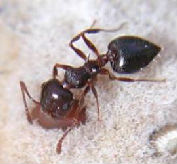
• Workers are about 1/8 to 1/4 inch long, light brownish-yellow, and are recognized by a heart-shaped abdomen.
• Acrobat ants may nest both outdoors and indoors.
• Outdoor nests are most often in dead and decaying wood such as logs, stumps, dead trees limbs, firewood and hollow tree cavities.
• Nest indoors where moist, damaged wood is present. Therefore, their presence in structures often means a moisture problem or water leak is present. They may also nest in foam insulating board or sheathing.
• Workers feed on live and dead insects, as well as honeydew from aphids and mealybugs.
• When colonies are disturbed, workers will readily bite and emit a repulsive odor.
Argentine (Argentinians)
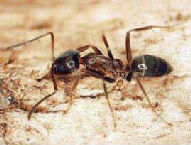
• Workers are approximately 1/8” long and light to dark brown in color.
• Argentine ants have a constricted petiole with one node and the 12-segmented antenna has no club.
• Nest in soil exposed or protected under mulch, rotten wood, standing dead trees, debris, bird nests, bee hives, and many other places.
• Indoor nests are often found in walls of bathrooms and kitchens and in crawl spaces beneath the floor.
• Feed on both live and dead insects, as well as honeydew. They may be attracted indoors by many food types, but prefer sweet foods.
Bigheaded (Pheidole megacephala)
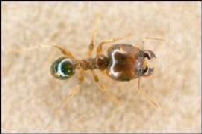
• Small, light brown to reddish brown to nearly black, dull ants
• Two-segmented petiole. Twelve-segmented antennae with three-segmented club.
• Two worker sizes – minor and major
• Nest in soil or under stones, logs, wood, or debris. Foraging trails are sometimes soil-covered and resemble subterranean termite foraging tubes.
• Feed on both living and dead insects. Collect honeydew from sap-sucking insects. Forage for sweets, fats, and proteins in homes.
Carpenter (Camponotus spp.)
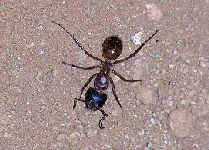
• Adults vary in length from about 1 /4 inch’’for a minor worker, to 1 /2 inch’’ for a major worker, and up to 7 /16 inch’’ for winged reproductives.
• Each colony has one functional, wingless queen, 9 /16 inch’’ long
• Carpenter ants have only one segment or node between their thorax and abdomen, a circle of hairs at the tip of their abdomen, and an evenly rounded thorax
• Cannot sting but can inflict painful bites with their powerful jaws and spray formic acid into the wound, causing a burning sensation.
• Omnivorous - eat a great variety of both animal and plant foods, including honeydew from aphids, scale insects and other plant-sucking insects, plant juices, fresh fruits, living or dead insects, other small invertebrates, common sweets such as syrup, honey, jelly, sugar and fruit, and most kinds of meat, grease and fat.
Yellow crazy (Anoplolepis gracilipes)
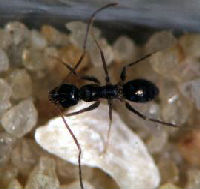
• Small workers about 1/8-inch (3 mm)
• The body has long coarse hairs
• Easily recognized by extremely long legs and antenna
• When disturbed, run erratically with no apparent direction
• Nests in places such as trash, refuse, cavities in plants and trees, rotten wood, in soil under objects and also have been found under debris left standing in buildings for long periods of time
• Workers are omnivorous, feeding on live and dead insects, seeds, honeydew, fruits, plant exudate, and many household foods
Ghost (Tapinoma melanocephalum)
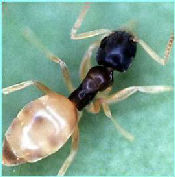
• Ghost ant workers are extremely small, 1.3 to 1.5 mm long and monomorphic (one-sized)
• Head and thorax are a deep dark brown with gaster and legs opaque or milky white
• Runs in quick, erratic movements when disturbed
• When crushed, the workers emit an odor similar to that of rotten coconuts
• Establishing colonies is most likely by budding
• Multiple queens may be spread out into multiple sub-colonies.
• Nest in areas such as tree cavities, under loose bark, at the base of palm fronds, in flowerpots, in and under firewood and under objects on the ground, in wall voids, between and behind cabinets, in potted plants brought indoors and in almost any protected area.
• Feed on honeydew from sap-sucking insects and will also scavenge for dead insects, indoors they are attracted to sweet and protein foods and may infest packages of these foods if accessible.
Odorous house (Tapinoma sessile)
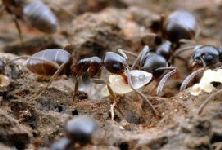
• Workers are all the same size, small, 1/8-inch long
• Dark brown to shiny black
• Very strong odor when crushed
• When disturbed, become erratic with their abdomens raised in the air
• Nest in various habitats including wooded areas, beaches, wall voids, and around water pipes and heaters
• Feed on both dead and living insects, favoring aphid and scale honeydew. In homes, forage primarily for sweets
Pavement (Tetramorium caespitum)
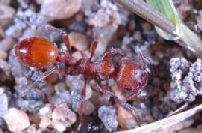
• Workers are all the same size, 3/16-inch long
• 12-segmented antennae with 3-segmented club
• Feed on honeydew, insects, sweets, fruit, and greasy foods. These ants can also be found feeding upon pet foods.
• Move in slow deliberate motion and are not easily disturbed
• Nest near or in cracks of pavement, along curbing or in soil beneath stones
• Mounds are built along sidewalks, baseboards, and near foundations in clusters
Pharaoh (Monomorium pharaonis)
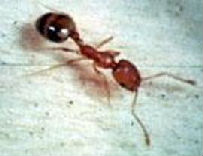
• Also called "sugar ant"
• Body length 1/12 to 1/16 inch long (monomorphic)
• Body coloration varies from golden yellow to reddish-brown Have 12-segmented antennae that ends with a 3-segmented club
• Nest in household structures such as wall and cabinet voids, behind baseboards, behind refrigerator insulation, inside hollow curtain rods, or in the folds of sheets, clothes, or paper. Outdoors nest in debris or cracks and crevices
• Feeds on sweets (jelly, sugar, honey, etc.), cakes and breads, and greasy or fatty foods
• Colonies very mobile; workers, along with larvae, pupae, and even a few queens, may move to new locations if disturbed or if colony becomes too large
Little black (Monomorium minimum)
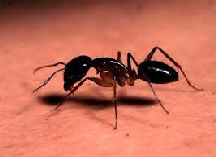
• Body 1/16 inch in length (monomorphic)
• Antennae have 12 segments with a 3-segmented club
• Shiny black
• Colonies are moderate to large and contain multiple queens. New colonies are formed by swarmers
• Little black ants may invade homes in search of a wide variety of foods including sweets, meats, grease, and bread. Outdoors, this ant feeds on insects, honeydew, pollen, and sweet plant secretions.
• Nest in many different places, including in mulch, logs, stumps, and in piled items
Fire (Solenopsis spp.)
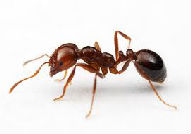
• Workers are polymorphic (different sizes), small, 1/16- to 1/5-inch long
• Body reddish with shiny dark brown gaster with stinger
• 10-segmented antennae with 2-segmented club
• Extremely aggressive; if disturbed, will swarm out of nests and attack in large numbers; can inflict a very painful sting
• Nest in mounds with multiple openings in soil or lawns, usually in open sunny areas near a water source
• If undisturbed, mounds may reach up to 18 inches high and 24 inches wide; they become dome-shaped after 2-3 years
• Feed on living insects, dead animals, and honeydew from honeydew-producing insects. In homes, forage on sweet foods, proteins, and fats
Thief (Solenopsis molesta)
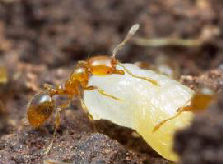
• Workers are all the same size, tiny, 1/32-inch long
• Yellow to light brown with very small eyes
• 10-segmented antennae with a 2-segmented club ; often confused with Pharaoh ant, (Pharoah ant has 3 segments).
• Nest outdoors in soil under rocks or in decaying wood. Indoors, colonies found in cabinet or wall voids or behind baseboards
• Feed on grease and greasy foods, proteins, dead insects, and even dead rodents; may sometimes feed on sweets
• Often steal food and ant larvae from nests of other ants
Weaver (Oecophylla smaragdina)
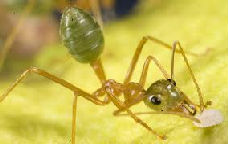
• Particularly attracted to nectar
• Weaver ants do not have a stinger, but inflict a painful bite which is aggravated by irritating chemicals secreted from their abdomen
• Choose living leaves to build nests - these provide well camouflaged protection from predators and the elements
Bed Bugs
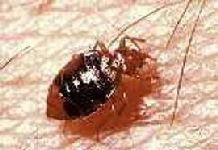
• Adult bed bugs are brown to reddish-brown, oval-shaped, flattened, and about 3/16 to 1/5 inch long.
• Their flat shape enables them to readily hide in cracks and crevices.
• The body becomes more elongate, swollen, and dark red after a blood meal.
• Bed bugs have a beak like piercing-sucking mouth part system
• Bed bugs do not fly, but can move rapidly over floors, walls, ceilings and other surfaces
• Female bed bugs lay their eggs in secluded areas, depositing 1, 2 or more eggs per day and hundreds during a lifetime
• Nymphs can survive months without feeding and the adults for more than a year
• Bed bugs are active mainly at night. During the daytime, they prefer to hide close to where people sleep
• Their flattened bodies enable them to fit into tiny crevices — especially those associated with mattresses, box springs, bed frames and headboards
• Bed bugs usually attack humans, but may feed on other warm-blooded animals, including pets
• All people are not equally sensitive to bed bug bites, so while some victims break out in rashes from the bites, other people may not display symptoms
Bed Bug control
Step 1 Prepare the area : Pre-treatment Procedures
• Reduce clutter to make inspection easier.
• Personal items (stuffed animals, soft toys, blankets) should be removed, cleaned with a vacuum cleaner, and bagged in plastic for for a couple of days with strips if infestation is severe. You can also bag your laptops, phones, radios in a bag as well. The insecticide in the strips will not harm these items and is a non residual, so you don't have to launder these items after using the strips
• If you dismantle the bed frames, you may expose additional bedbug hiding sites.
• Remove drawers from desks and dressers and turn furniture over, if possible, to inspect and clean all hiding spots.
• Stand up the box spring and shine a flashlight through the gauze fabric to expose bed bugs. If the fabric is torn (possible hiding place), remove fabric to prepare for spraying.
• Caulk and seal all holes where pipes and wires penetrate walls and floor, and fill cracks around baseboards and moldings to further reduce harbor ages.
• Since infested garments and bed linen can't be treated with insecticide they will need to be laundered in hot water (120°F minimum). If washing is not available, sometimes heating the garments or bed linen for several minutes in a clothes dryer may work.
• Thoroughly clean the infested rooms .Scrub infested surfaces with a stiff brush to dislodge eggs.
• Vacuum in area of bed bug harbor ages with an vacuum attachment. Vacuum along baseboards, nearby furniture, bed stands, rails, headboards, foot boards, bed seams, tufts, buttons, edges of the bedding as well as the edges of the carpets (particularly along the tack strips) are key areas to vacuum. A good vacuum cleaning job may remove particles from cracks and crevices to encourage greater insecticide penetration.
• Discard vacuum cleaner bag in a sealed plastic bag when finished.
• Caulk cracks and crevices in the building exterior and also repair or screen openings to exclude birds, bats, and rodents that can serve as alternate hosts for bed bugs.
Step 2 Inspect : Look For The Bugs
To inspect well, it may be helpful to briefly understand Bed Bug Diet and Bedbug Habits. Because the bed bugs may be difficult to see with the naked eye, we recommend an industrial powered magnifier such as flashlight.
The common bed bug is visible to the naked eye. Adult bed bugs are brown to reddish-brown, oval-shaped, flattened, and about 1/4 to 5/8 inch long. Their flat shape enables them to readily hide in cracks and crevices. After a blood meal, the body elongates and becomes swollen. Eggs are not known to be placed on the host's body but are found on surfaces near where the host sleeps.
Look in any place that offers darkness, isolation and protection. These bugs will often wander. Inspect adjoining rooms where an infestation is found. Even when the bed bugs themselves cannot be found, their hiding places can be located by looking for the spots of fecal material they often leave in easily visible places.
Fecal spots and the bloody spots (looks like rust) left on sheets and pillowcases when engorged bugs are crushed serve as sure signs of infestation. Adult bed bugs are about 1/4-inch long and reddish-brown, with oval, flattened bodies. Bed bugs prefer to hide in cracks and crevices during the daytime and come out to feed on the host's blood at night, usually while the host is sleeping. Because they can flatten their bodies, they can fit in very small crevices, specially around the bed area. They are found in habitual hiding places, preferably close to a blood meal. Even though the their preference is to be close they will travel several feet for a blood meal. Initial infestations tend to be around beds, but the bugs eventually may become scattered throughout a room, occupying any crevice or protected location. They also can spread to adjacent rooms or apartments.
Look for areas close by where the bed bugs are biting. Main areas of inspection are cracks and crevices in head and foot boards and attached side railings and supports. Look for any cracks or crevices where bed bugs may crawl into to hide. If the top of the mattress has any rips , the bed bugs may hide there as well. Look also in your box springs, both top and bottom for any rips that might shelter these bugs.
Inspection Check List
• Cracks and crevices in head and foot boards, attached side railings and supports
• Inspect mattresses top, sides and bottom. Check all buttons, seams and rips.
• Inspect electrical switch plates, pictures on walls, wall posters
• Inspect cracks in plaster or seams in wall paper.
• Inspect electrical appliances-radios, phones, televisions, ect., looking in hiding places.
• Inspect tack strips under wall-to-wall carpeting and behind baseboards
• Inspect secondhand beds, bedding, and furniture. The newer better built mattresses do not offer as much shelter and protection for the bed bugs to hide.
Step 3 Treat the Bed, Headboard, Frames and Footboards
Do I Have to Throw Out the Mattress?
This question would be answered upon the condition of the mattress or size of infestation. If there are holes or tears in the gauze fabric or fabric of the mattress, bed bugs and eggs may be inside, as well as outside. There are restrictions on how beds can be treated with insecticides. We do carry a line of mattress covers and box spring covers that are bedbug certified to place over your mattress or box spring so you don't have to throw them away. If using an labeled insecticide on the mattress or box spring, apply on mattress or box springs and zip it up. The mattress and box spring covers are so good that you don't even need to treat the mattress or box springs with an approved insecticide. It has a patented hook to keep the bed bugs inside the encasement, they cannot escape. Keep the encasement in place for one year (due to bed bug cycles).
How to treat the mattress with insecticides:
Look carefully at the folds and seams of the mattress, the headboard, foot board (if present), box spring/support platform, frame, etc for bedbugs and treat these area after vacumming.
Step 4 Treat all baseboards and furniture (Night Stand, Chests, Dressers, Couches and Chairs)
Spray liquid insecticides or aerosols :
• Spray around and under the bed and along the baseboards near the bed. After removing the drawers from the furniture, the inside of the cabinetry should be sprayed as well as the bottom and sides of the drawers. Do not treat the inside of the drawers. If needed the clothes in the drawers should be removed and laundered.
• Spray around the inside of the closet, door frame and door.
• Spray molding at top and bottom of room. Spray around windows.
• Spray seams of drawers, both top and bottom. Spray dressers from below. Spray where dressers touch the floor.
• Spray where bed touches floor, spray chairs and underneath chairs.
• Spray all baseboards, loose plaster, behind bed frames and headboards, beneath beds and furniture, and bedsprings and bed frames. Do not apply to furniture surfaces or mattresses where people will be laying or sitting. Infested bedding should not be treated, but should be removed, placed in sealed plastic bags, and taken for laundering and drying at high temperatures.
Dust Usage: (Do not dust on top of moist insecticides)
Put dust into duster. Remove switch plates and electrical outlet covers and dust into the openings. Dust any items hanging on the wall such as pictures with a small paint brush. Use a small paint brush to paint dust in seams and around buttons of mattress. Use dust or aerosol in all joints of the bed frame. If possible disassemble bed frame and treat from all angles with dust and aerosol. After the mattress and box spring has been treated enclose both of these. With these covers you can keep your bed and do not have to treat it again.
Preventing Bed Bug Infestations
It’s important to inspect used furniture, particularly bed frames and mattresses before bringing it into the home. Mattresses, in particular, carry the greatest risk of harboring Bed Bugs and their eggs. You should be wary of acquiring used furnishings, especially beds and couches. A practice that we have incorporated in our traveling is to inspect for bed bugs in hotel rooms. If possible, carry a flashlight with you and inspect the bed area completely as described above. Also, you may want to inspect or vacuum luggage when you arrive home to prevent any transference.
A second common source for bedbug infestation occurs in homes where bats, swallows, chimney swifts, pigeons, or other wild hosts have been roosting. Although similar in appearance, these bedbug species that normally feed on bats and birds can be differentiated from the Common Bedbug that prefer humans. The bat bedbug can and often feeds on humans. The bat bedbug has long hairs on it's body. Eliminate their bat hosts from the building and seal all openings so that bats cannot enter. Another group of bugs resembling the bed bug infest birds. These bugs are usually confined to bird nests. To control these parasites, the birds and their nests must be removed, and an application of with a residual spray.
Bee & Wasps
• Wasps and bees are beneficial insects, although they are generally considered to be pests because of their ability to sting
• These insects are beneficial in their activities, particularly as predators of pest insects and as pollinators
• It is important to distinguish between these insects because different methods may be necessary to control them if they become a nuisance:-
• Wasps appear smoothed-skinned and shiny
• Bees are fuzzy and more robust in appearance
• Wasps are predators, feeding insects and other arthropods to their young
• Bees feed on nectar and pollen from flowers
• Wasps build nests out of a papery material. Wasps may nest in the ground, in trees and shrubs, under horizontal surfaces such as eaves, and in buildings where they occupy wall voids and similar spaces
• Bees build combs made of wax
Common bee & wasp species
Honey bees
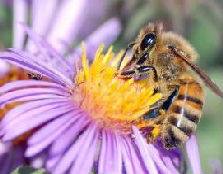
• Honey bees are about 0.5 inch long with a fuzzy light brown to black appearance, with striped brown and black abdomens
• They are considered to be the most beneficial species of insect because they pollinate plants and produce honey and bee's wax
• Honey bees live in extra large colonies of up to 50,000 individuals
• The nest consists of several tiers or combs made of beeswax. It is located in cavities of trees, rock formations and buildings
• There is a lower risk of being stung around a swarm because it is a period of vulnerability and the colony has no hive or honey to protect
Bumble bees
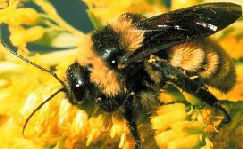
• Bumble bees are robust and densely covered with black and yellow hairs
• They range in size from about 0.5 to 1.0 inch long
• Bumble bees inhabit nests in old rodent burrows, under porches and in wall voids
• Bumble bees usually are not overly aggressive, but they will sting if molested
Carpenter bees
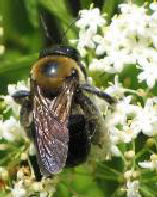
• This bee is a bumble bee look-alike that has a shiny, all-black abdomen, whereas the bumble bee’s abdomen is fuzzy, black and yellow
• Carpenter bees make their nests in beams, rafters, telephone poles, and other wooden structures
• Females chew ½-inch diameter holes in wood and bore tunnels that run several inches into the wood inside, eggs are laid and the resulting larvae develop on a mixture of pollen and nectar
Yellowjackets
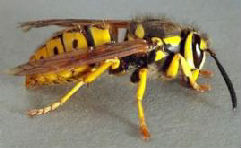
• Yellowjackets are banded yellow or orange and black and are commonly mistaken for honey bees, but they lack the hairy body and are more intensely colored
• Yellowjackets typically nest underground using existing hollows. Occasionally nests can be found in dark, enclosed areas of a building, such as crawl spaces or wall voids
• Yellow jackets are excellent predators of potential pest insects
• When temperatures cool in late summer, yellowjacket numbers peak just as their insect food supply begins to decline. They scavenge more aggressively at this time, taking food from trash containers and picnickers
• When disturbed, yellowjackets can sting repeatedly; their stingers are not barbed nor lost after stinging like those of honey bees
Hornets
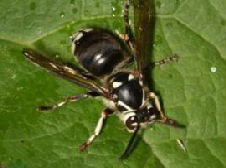
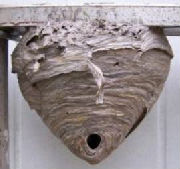
• The so-called bald-faced hornet about ¾-inch long, black and white, with white face, is actually a larger yellowjacket species
• Its nest is the familiar basketball-size papery oval hanging from tree limbs and sometimes structures
• Nests occur in trees and in attics and wall voids of structures near forested areas
• Nests often attract attention because of their large size, but hornets rarely sting unless the colony is seriously disturbed
• Hornets feed their young live insects and do not share the scavenging habit of yellowjackets
• Baldfaced hornets are beneficial because they capture other insects
Paper wasps
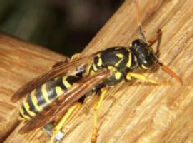
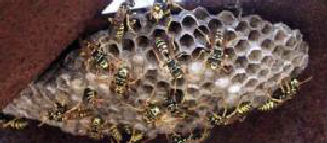
• Paper wasps are about 0.7 to 1.0 inch long, slender and variously colored with brown, red and yellow
• They build their single-comb unprotected nest from the eaves or porches of buildings or other sheltered locations
• Paper wasps are beneficial predators of caterpillars and other insects and do not scavenge
Mud Daubers
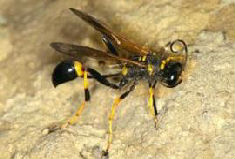
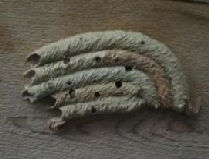
• Mud daubers vary in length from 0.5 to 1.25 inches and are very slender with threadlike waists
• Mud dauber wasps are named for their habit of constructing tubular nests of mud plastered on the exterior surfaces of structures
• Its nests are about 2 inches long
• Mud daubers usually sting only when pinned against the skin
Cicada killers
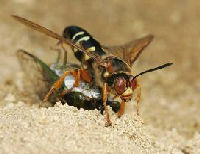
• The cicada killer wasp is 1.5 to 2.0 inches long, and is brownish black with yellow markings on the abdomen and face
• The female digs a burrow in the soil. It captures cicadas, paralyzing them by stinging, and places them in the burrow
• Inside it lays an egg on the cicada, then covers the burrow with soil
• Larvae consume the paralyzed cicada and emerge as adult wasps the following spring
• The only damage these wasps cause is the unsightly dirt piles dug out to create nests
Cockroaches
• Cockroaches are medium-sized to large insects in the order Dictyoptera
• They are broad, flattened insects with long antennae and a prominent, shield-shaped section behind the head called a pronotum
• A cockroach has three stages during its life cycle: egg, nymph, and adult
• Cockroaches are nocturnal, hiding during the day and becoming active at night
• All cockroaches are scavengers and will survive on almost any food as well as backing glue, leather, bookbinding's, bar soap
• Cockroaches are known to carry human pathogens, such as Salmonella and E. coli, which can result in human diseases, such as food poisoning or diarrhea
Common cockroach species
American cockroach (Periplaneta americana)
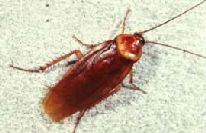
• Largest cockroach species to infest buildings
• Both the adult male and female is about 1-1/2 to 2 inches long, reddish brown and possesses long wings that cover its abdomen
• A female typically produces 9 to 10 egg cases which are deposited carefully in a crack or crevice
• Each egg capsule contains about 12 young; a female and her offspring can produce over 800 cockroaches in one year.
• An American cockroach has a fondness for fermenting foods, e.g. bread soaked with beer
• Their foraging is confined mostly to the basement and ground floor of a building unless suitable conditions exist in higher locations
German cockroach (Blattella germanica)
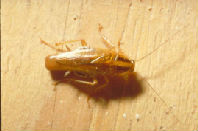
• The adult is about ½ inch long, light brown or tan, and has two dark longitudinal bands or streaks on the prothorax behind the head
• This species has the highest reproductive potential of all the common pest cockroaches
• Females produce about 30 to 50 eggs at a time
• Each egg case contains about 30 young, and a female may produce a new egg case every few weeks
• The female carries the egg case until the eggs are ready to hatch
• It generally inhabits kitchens and bathrooms where they are found near plumbing fixtures, in cracks or crevices in cupboards, under drawers and kitchen sinks, and similar locations
Brown banded cockroach (Supella longipalpa)
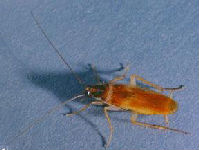
• The brownbanded cockroach is similar in size and color to the German cockroach
• It can be distinguished by the lack of brown bars on the shield in front of the wings and by the presence of two light bands across the wings and abdomen
• The adult brownbanded cockroach is about ½ inch long
• An adult male is golden brown and has a narrow body with its wings extending beyond the tip of its abdomen
• A female adult is dark chestnut brown, has a teardrop-shaped body, and its wings do not completely cover the abdomen
• Both sexes have distinctive horizontal yellow bands
• Brownbanded cockroaches prefer starchy food (e.g., glue on stamps and envelopes), are often found in offices and other places where paper is stored, and are more common in apartments or homes that are not air conditioned
• Females glue light brown egg cases, which are about 1/4 inch long, to ceilings, beneath furniture, or in closets or other dark places where eggs incubate for several weeks before hatching
• Each female and her offspring are capable of producing over 600 cockroaches in one year
Oriental cockroach (Blatta orientalis)
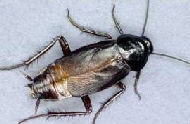
• An adult Oriental cockroach is about 1 to 1-1/4 inches long and dark brown, almost black
• A male has fully developed wings which are shorter than the body
• A female has very short, rudimentary wings
• A female deposits an average of eight egg cases during its lifetime; each capsule produces about 16 young
• An Oriental cockroach produces a strong smell and is considered one of the dirtiest of all the cockroaches
• Commonly found in damp basements, cellars, crawl spaces, and sewers, near drains, leaky water pipes and under refrigerators, sinks, washing machines, and floors
• It feeds on all types of garbage and other organic material
Cockroach control
Concepts of cockroaches
• The cockroaches in the buildings are not only one kind, so it is more import to identify the cockroach type than deciding the way to control the cockroach.
• Most of the cockroach controls must been carried more than once to receive the efficacy, because it is hard to control the cockroaches effectively by only carrying one time. (One possible situation is to use foggy spray that can kill all the housing cockroaches, but this method can not prevent the cockroaches from attacking again.)
• The successful way to control the cockroaches must include knowledge, experience and techniques, and not just only apply the pesticide.
The first step to control the cockroaches is to clean the environment, because it can remove the food, water and hidden places of cockroach. Also, it is very important to repair the wall or the holes that cockroaches may use it as their hidden place, because those hidden places may affect the efficacy of the pesticide or poison baits. Use a container to keep the food well, close the garbage cans and remove the old papers and boxes. Especially, do not leave any food in the kitchen after cooking everyday, and the kitchen must keep dry, because cockroaches can endure long-term starvation, but they can’t endure to the dryness. Cockroaches will not easily survive if they can’t find the water for over one week, however they can find the water easily by using their keen sense of smell. Especially cockroaches can find the water at some places around the kitchen where people may ignore, like the water plate that beneath the refrigerator, wet dishcloths and so on. So it is important to remove the water sources for cockroaches. Fill the chinks or use screening to fill the holes are the good ways to stop cockroaches, and keep the food or garbage in a plastic bag can avoid the cockroaches from polluting the food. There are many kinds of cockroach catchers and cockroach glue traps in the market today, and some of them are with baits, and some of them have the ingredient of Sex pheromone. Besides, there is still no evidence on the efficacy of supersonic repellents by scientific report.
The way to control the cockroaches should depend on what type of the cockroaches are. German cockroach, American cockroach, Australian cockroach and brown cockroach are the common ones we can see in our daily life, however, when control each of them must use different way. For example, German cockroaches like to hide in the chink of the wall or other objects, under the sink, in the cabinet, under the refrigerator, in the electricity box and so on. American cockroach, brown cockroach and Australian cockroach usually hide in the water pipes, gutters, drainage, subways and so on, so, it is very important to close the entrance of those places to prevent cockroaches from hiding there.
Birds
• A number of bird species may cause nuisance or damage problems in urban areas. These include crows, house sparrows, pigeons and others
• House sparrows, pigeons, and crows cause problems around businesses, homes, public buildings and other structures because of their droppings, feeding, roosting, and nest building activities; associated public health concerns; and other factors
• Droppings in water may lead to algae growth and possibly fish kills, and water contamination poses health concerns, particularly when in municipal water supplies
Common birds species
Crows
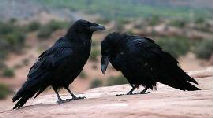
• Crows are identified by their black feathers, black eyes and the caw-caw sound they make
• Crows are diurnal
• Crows are omnivorous, eating almost anything, and they readily adapt food habits to changing seasons and available food supply
• Crows are also very territorial. They will come to the aid of unrelated crows in need of help or distress
• Roosts are health hazards. Crows have been found with the West Nile encephalomyelitis virus
Pigeons
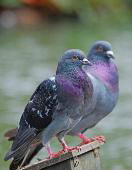
• Pigeons typically have a gray body with a whitish rump, two black bars on the secondary wing feathers, a broad black band on the tail, and red feet
• Body color can vary from gray to white, tan, and black
• Pigeons are primarily grain and seed eaters. They will also feed on garbage, livestock manure, insects, or other food materials
• Pigeon droppings deface and accelerate the deterioration of buildings and increase the cost of maintenance
• Pigeons may carry and spread diseases to people and livestock through their droppings. They are known to carry or transmit encephalitis, toxoplasmosis, salmonella, and several other diseases
House sparrows
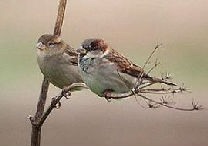
• Adult House Sparrows are small birds; 6–7 inches (15–17 cm) long with a 9-inch (23-cm) wingspan
• Male House Sparrows have gray bodies and brown backs streaked with black and can be easily recognized by the reddish-brown stripes above their white cheeks and by the black bib on their throat and upper chest
• Female House Sparrows are similar in appearance, with gray-brown bodies and brown backs streaked with black. However, the female has gray and brown streaks on both sides of her head above her cheeks
• The diet of the House Sparrow consists mainly of plant seeds, grains, birdseed, and human food scraps, except during the breeding season when they prey heavily on insects
• House Sparrows are highly social, roosting and nesting communally, but will fiercely defend small territories around nest sites
• House Sparrows build messy nests of dried vegetation in any available space around signs or under the eaves, gutters, and drain pipes of commercial buildings and residences. Their nests can damage insulation, cause fire hazards , or clog drain pipes and gutters
• Their droppings often accumulate on the walls and sidewalks of businesses, creating an unsightly mess that is unappealing to patrons and difficult to remove
• House Sparrows can carry a variety of zoo noses, diseases that can be spread to humans (often through feces), and act as amplifying hosts, allowing the infectious agent to multiply rapidly
Bird control
1. Repellents
• Tactile repellents are soft, sticky, nontoxic substances that discourage birds such as pigeons, crows, or house sparrows from perching on ledges, beams, or similar areas
• These are best placed on wide masking tape strips to facilitate removal and will be replaced periodically because dust and dirt coat the sticky surfaces
2. Bird Spikes
• Bird spikes can be used to protect ledges, signs, beams, chimneys, cutouts, security cameras, lights, column tops and more from roosting pigeons, gulls and other large problem birds
• Pest birds such as pigeons and gulls like a flat surface to land on bird spike prevent them from landing to gain a foothold
3. Bird Nets
• Bird netting is the strongest and most versatile bird exclusion system in the world.
• Bird net denies pest birds access to literally any architectural configuration including courtyards, rooftops, overhangs, parking garages, etc.
Flies
• All flies belong to the insect order Diptera, which means two wings.
• All flies undergo complete metamorphosis with egg, larva, pupa, and adult stages in their development
• Flies perform a vital function as decomposer of dead organisms, manure and decaying vegetation
• Flies may act as carriers of disease organisms present in their breeding and egg-laying sites
• These disease organisms can cause food poisoning, diarrhea, dysentery or typhoid fever
Common fly species
Blow fly (Calliphoridae)
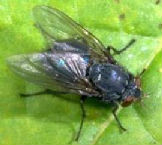
• Adult flies are metallic blue, green, copper or black colored flies that otherwise resemble house flies in appearance
• Common species include the greenbottle flies (Lucilia spp.), black blow fly (Phormia regina), and various Calliphora species
• Lay their eggs on the carcasses of dead animals, decaying meat or garbage that contains meat scraps
• Large numbers of blow flies occur when a dead animal - usually a mouse or squirrel - dies within the home
• Although such occurrences are unpleasant, they are usually short-lived and self-limiting, as the insects are only capable of breeding on freshly killed animals
House fly (Musca domestica)
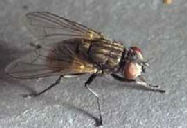
• The house fly is the most common fly pest around homes
• House flies generally are gray, with the thorax marked with four dark stripes
• Female flies lay numbers of eggs in suitable larval food sources such as decomposing food in garbage, animal excrement or other decomposing organic materials
• The adult flies feed on a wide range of liquid waste but can eat solid foods, such as sugar
• To digest solid foods, house flies liquefy food by regurgitating it and thereby are ideally suited to mechanically transmit disease organisms such as diarrhea and dysentery, to people
Stable fly (Stomoxys calcitrans)
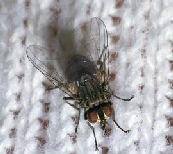
• Stable flies are also called biting house flies
• The stable fly is a about ¼-inch long and gray with four dark stripes on its thorax
• This fly looks like a house fly, except for the pointed proboscis beneath its head through which it sucks blood
• They typically bite in early morning or late afternoon and often attack the ankles, inflicting a sharp, stabbing pain
• Stable flies lay eggs in piles of rotting vegetable matter, such as haystacks, grass clippings, manure and vegetation along shorelines
Flesh fly (Sarcophagidae)
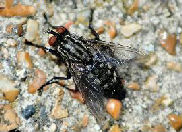
• Flesh flies are gray with three dark stripes on its thorax
• They are slightly larger than house flies and have a checkerboard pattern on the abdomen
• Flesh flies are attracted to sources of decay around the home, including garbage dumpsters, compost piles and dead animal carcasses
• Flesh flies are helpful in forensic entomology because they are usually the first to arrive at a carcass after an animal dies
• Flesh-flies can carry leprosy bacilli and can transmit intestinal pseudomyiasis to people who eat the flesh-fly larvae
Vinegar fly/Fruit fly (Drosophila melanogaster)
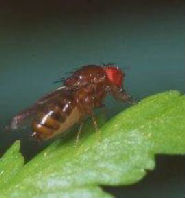
• Vinegar flies are small, slow-flying insects usually found in association with over-ripened fruit and vegetables, and are sometimes inaccurately called fruit flies
• Vinegar fly adults vary from 3 to 4 mm in length, have reddish eyes, are light yellowish brown to dark brown in colour, and may have darker markings on the dorsum of the thorax in the form of spots, blotches, or lines
• Vinegar flies are common nuisance pests in restaurants, grocery stores, fruit markets, canneries, homes, and other locations that may attract these insects with fermenting or rotting vegetative matter
Fly control
Remove every kind of organism and delete the source of attracting flies are the key way to control the flies. When handling the garbage, the process including storage, collecting, moving, and so on, any of them may cause the reproduction of fly.
Physical Control Method: Using physical method to control or kill fly also can reduce the damage that caused by fly. Fly glue trap, glue board, electric repellent lamp are all can be used indoor for control of flies.
Chemical Control Method: This method mainly uses pesticide to control the flies, and apply space spray, residual spray, poison baits and soaked fly rope. Also, he method can be discussed as under:
• Usually it is hard to control the larvae of fly by applying larvicide. Due to the organism accumulates constantly at the place where the larvae breed, so it is need to apply the baits 1~2 times a week. Also, the baits can kill the natural enemy of fly, and it will help the formation of fly’s resistance to the bait. Spray the amount of the baits in the area that flies gather, and the bait amount must cover the upper side of the area (10~15cm range). Sometime it is also ok to apply dust powder bait or granule bait.
• Apply residual spray in the place where the adult flies inhabit: Spray mainly in the place where flies inhabit, and usually it is better to spray before the quantity of the flies not reach to the peak. The efficacy of the flies control depends on the after conditions: what kind of bait is used, the way of spraying, temperature, humidity, the sunlight and so on. When using the sprayer with law pressure, it is suggested to spray 4~8 liters at 100 m2. Usually the baits can be mixed with sugar before spraying, and this way can get better efficacy. It is forbidden to spray the baits with organophosphates in some places like restaurant, kitchen, milk factory, cow house, chicken house and so on, however for those places it is suggested to spray the baits with Parathyroid like Cypermethrin, Permethrin, Deltamethrin and so on.
• Soaked fly ropes: Flies like to stay on the linear objects, so it is a good way to soak the rope in the baits and to attract the adult flies stay on the rope and kill them. Especially the soaked rope way can be applied in the places where are not proper to spray the baits, like animals’ houses, chicken house, market, stores and so on. Usually we soak the ropes with Fenitrothion and add sugar on the rope will be more effective. Hang the ropes vertically, and use dark or red ropes will be better.
• Space spray: Use Parathyroid or Piperonyl Butoxide when apply space spray indoor, and it can knock out the flies effectively, and it contains law toxicity to other animals.
• Directly spray to the gathered flies: Use pesticide and directly spray it to the place where flies gather, like a garbage dump, garbage truck and so on. This way is also can kill the flies effectively.
After changing to use the septic tank instead of the manure pit, the quantity of fly decreased a lot.
• Close the places where possibly breed the flies, and it can remove the multiplying of the flies.
• Using conveyor belt to handle the dung and urine of the livestock or collecting it by man in a closed area.
• Install the screen windows around the excrement bed, and use pesticide to apply residual spray on the screen windows; or change the screen windows as electric ones to kill the female flies that come to produce the eggs.
• Keep dry of the place where collecting the excrement, and it is better to use dry stuff there.
• Put a dryer below the chicken cages to keep the cages dry, and it can ease the smell of the chicken excrement to prevent luring the flies.
• Dead chickens and broken eggs are easily to attract the flies, so it is need to clean the dead chicken and broken eggs everyday.
Application of fly management experience in the dumps:
• Using pesticide and directly spray it to the place where flies gather. Especially apply the pesticide and spray it at night time while the flies are sleeping, and the result will be more effectively.
• The pesticide that used to control adult flies and larvae should not have the same chemical function in order to avoid the flies have resistance or cross resistance to the pesticide.
• Due to the life history of fly is short, so it is better not to use Parathyroid by applying residual spray, because when the Parathyroid decompose to the law concentration, it will easily release the resistance for the flies.
• Use the fly catch rope and hang it on the ceilings of the pig house or chicken firm. Soak the rope with glue or dip in the pesticide that mixed with 10% of sugar.
• Protect well the natural enemies of fly (birds, frogs and so on).
Collecting, specializing and combination are the way to handle the organic fertilizer (excrement and urine) of Birds and livestock.
• The raw excrement of chicken can easily to attract flies, so it should be decomposed thoroughly first before being used as fertilizer.
• Using pesticide, microbial agent, insect growth regulator and calcium cyan to mix with the excrement of livestock and ferment airtight for 3 days, and it can effectively kill the maggots of fly.
• Soak the fishing net in the pesticide, and hang the net inside/outside of the chicken firm, pigpen, bullpen to kill the adult flies.
• The right time to use the electric fly trap is when the sun set. Notice the right ways to use the electric fly trap.
Combining ways to control flies: There are many ways to control flies, and each way has its advantage and limitation also. In addition, if only use one way to control flies, the flies will become to get with it in the long run and even will have resistance to the way. So, the ideal way to control flies is to use at least 2 ways at the same time, and change to use other ways by turns in order to avoid the flies have the resistance to one of the ways. This ideal way is called combining ways.
Control of the flies together: In past, the sources of attracting the flies in Taiwan were fertilizer and garbage, and now the sources are the excrement and compost of livestock. The life history of fly is short, so if apply the pesticide not properly, it will let flies have the resistance easily. Also, fly has wings and that can make it fly 6~8 kilometers per hour. The smell sense of fly is very keen, so it will attract the flies if handling the excrement of livestock is not properly. So, the way to control of flies needs all people to do it together.
Fleas
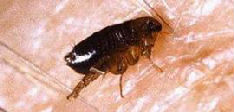
• Adult fleas are about 1/16 to 1/8-inch long, dark reddish-brown, wingless, hard-bodied (difficult to crush between fingers), have three pairs of legs (hind legs enlarged enabling jumping) and are flattened vertically or side to side allowing easy movement between the hair, fur or feathers of the host
• Fleas are excellent jumpers, leaping vertically up to seven inches and horizontally thirteen inches
• They have piercing-sucking mouth parts through which they obtain blood meals from their hosts
• Without a host, adult fleas live only a few days to 2 weeks
• Fleas do not survive well outdoors in hot, sunny lawns
• Fleas can be a source of both irritation and disease
• Dogs and cats scratch constantly when heavily infested, resulting in soiled and roughened coats and, sometimes, in nervous conditions
• The most serious effects occur when a pet develops an allergy to flea bites. As few as one or two bites can cause severe itching and scratching in allergic pets
• Although there are many different species of fleas, the most common ones are dog fleas and cat fleas
Flea control
Fleas are parasites, feeding directly on humans or other warm blooded animals. Usually you or your pet serve as these hosts.
A flea can jump 7 to 8 inches vertically and 14 to 16 inches horizontally. A skin reaction to a flea bite appears as a slightly raised and red itchy spot. Sometimes these sores bleed. Fleas usually require warm and humid conditions to develop. Due to the flea cycle and weather conditions, many people don't realize they have a flea problem until they return home from vacation or after a move to new premises and are confronted by hungry fleas. There are several types of fleas, but the most common is the cat flea, even on dogs. Fleas are attracted to body heat, movement, and exhaled carbon dioxide.
Flea Control Treatment
The best time to start a flea control program is in the late spring, prior to an infestation, since adult fleas comprise only 5% of the total flea population. To contain an infestation, fleas must be controlled in every way.
Frequently dust, sweep, vacuum, and mop all surfaces where pets or you have been. Eggs are laid on the pet and drop off as it moves. All affected pets should be treated at this time and removed from the premises for 4 to 6 hours. Remove birds from the home if you are using liquid insecticides. Cover or remove fish, and turn off the pump. You should keep covered shoes on until all treated areas have dried (4-6 hours) if you are using liquid insecticides.
1. Successful treatment with liquid treatments, involves the use of a residual insecticide concentrate to control the adult flea and an insect growth inhibitor (IGR) to prevent the larvae from developing.
This method lasts 4-6 months.
2. Successful treatment with Flea Powders ,involves the use of a Flea Stopper Flea Powder to dehydrate and kill fleas in two stages of the life cycle. Flea larvae, which hatch from the eggs, ingest the material and because it is a desiccant, it causes them to become constipated because there is not enough moisture to move their bowels. Consequently, they are poisoned by their own wastes and die, never developing into an adult flea. The adult flea is also killed by the dehydrating action of the granules.
This method lasts one year, however it takes 4-6 weeks to entirely cut the cycle and begin to see results. For that reason we have a complete kit to take care of the initial stages. You will need Ultracide Aerosol for the first 4-6 weeks, sprayed at intervals of 4-10 days. One can of Ultracide covers 1,000 sq. feet of carpet or 2,000 sq. feet of hard surfaces.
3. Successful treatments with aerosols would be using an aerosol that has a residual insecticide and an IGR mixed together. The advantage of using an aerosol over a liquid is that it is easier because you don't have to mix anything.
This method lasts 4-6 months.
Treating for fleas on your pet
Consult your vet about the health and skin condition of your pet prior to treatment. Begin flea control on the pet by using a mild shampoo and a sponge-type flea dip, flea spray, or flea shampoo.
Mosquitoes
• Adult mosquitoes are small, fragile insects with slender bodies; one pair of narrow; and three pairs of long, slender legs
• They have an elongate "beak" or piercing proboscis
• The mosquito goes through four separate and distinct stages of its life cycle: Egg, Larva, pupa, and adult
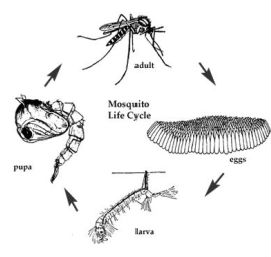
Aedes mosquitoes
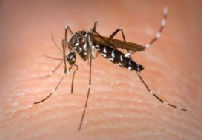
• Aedes mosquitoes have typical black and white stripe markings on their body and legs
• Eggs of these mosquitoes are laid singly or in rafts and although they may stick to the surface, they may sink if the water is disturbed.
• Aedes prefers clean water for the development of the larvae
• Only the female aedes mosquito bites as it needs the protein in blood to develop its eggs.
• Peak biting is at dawn and dusk.
• The average lifespan of an Aedes mosquito is 2 weeks
• The mosquito can lay eggs about 3 times in its lifetime, and about 100 eggs are produced each time.
• The eggs can lie dormant in dry conditions for up to about 9 months, after which they can hatch if exposed to favourable conditions, i.e. water and food
• Responsible for transmitting dengue fever, encephalitis, and yellow fever
Anopheles mosquitoes
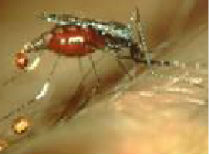
• Anopheles mosquitoes go through four stages in their life cycle: egg, larva, pupa, and adult
• Eggs are laid singly directly on water and are unique in having floats on either side
• Eggs are not resistant to drying and hatch within 2-3 days
• Anopheles mosquitoes can be distinguished from other mosquitoes by the palps, which are as long as the proboscis, and by the presence of discrete blocks of black and white scales on the wings
• Typical resting position: males and females rest with their abdomens sticking up in the air
• Anopheles mosquitoes are crepuscular (active at dusk or dawn) or nocturnal (active at night)
• Primary vector of malaria disease
Culex mosquitoes
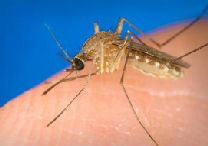
• Culex are medium-sized mosquitoes that are brown with whitish markings on the abdomen
• Typically bite at dusk and after dark
• Culex lay rafts of eggs on still water in a variety of natural and man-made containers, including tree holes, ditches, sewage and septic system water, storm drains, non-chlorinated swimming and wading pools, decorative ponds, bird baths, flower pots, buckets, clogged gutters, abandoned tires, and water-retaining junk
• Vectors of important diseases, such as West Nile virus, filariasis, Japanese encephalitis and avian malaria.
Mosquito control
Aedes aegypti are the prime media of disease, and the next is Aedes albopictus. The DENGUE HEMORRHAGIC FEVER won’t be occurred in the place where Aedes aegypti not inhabit there, however, if in the region that only have Aedes albopictus inhabit there, then it will be the only media of the disease.
In order to prevent the dengue fever from spreading and frequently relapsing, we should clean the sources of breeding the mosquitoes completely. Apply Silicon, Temephos or bti briquette in the man-made containers that with water, and the application to remove the sources of the mosquitoes should be carried frequently, if not the dengue fever may relapse.
When the dengue fever is prevailing, use pesticide and apply space spray. Also, you can try to kill the mosquitoes by soaking the clothes in the pesticide of pyrethroids and hang it indoor after drying, and the mosquitoes will die after contacting the clothes. Pay more attention to personal protection to avoid being bitten by mosquitoes.
Rodents
• Rats and mice are important rodent pests entering homes and warehouses for food and harborage
• Rats contaminate 10 times as much food as they eat, with urine, droppings and hair
• They can carry at least 10 different kinds of diseases including bubonic plague, murine typhus, spirochetal jaundice, Leptospirosis, rabies, ratbite fever, and bacterial food poisoning
• Rats and mice also start fires by gnawing matches and electrical wires in homes
• The Norway rat, roof rat and house mouse are the most persistent rodent populations in need of control
Common rat species
Norway rat (Rattus norvegicus)
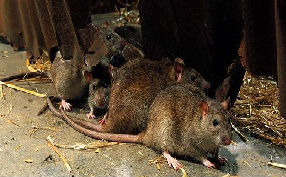
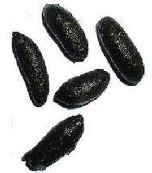
• The Norway rat, also called the brown rat or sewer rat is a destructive pest found in urban and suburban neighborhoods
• Norway rats are husky, brownish rodents that weigh about 11 ounces
• They are about 13 to 18 inches long including the 6 to 8 1/2 inch tail
• Their fur is coarse and mostly brown with scattered black on the upper surfaces
• Their droppings are 3/4 inches long and capsule-shaped
• Norway rats generally prefer to eat fresh meat, fish, and grain, they can survive quite well on an ounce per day of garbage or decayed food along with an ounce of water
• Norway rats are burrowers and often dig in rubbish and under buildings or concrete slabs
• Burrowing can cause damage by undermining the foundations of buildings, disfiguring landscape plantings and blocking sewer lines
• Norway rats live about 1 year and reach sexual maturity in 3-5 months
• They have 8-12 young per litter and up to 7 litters per year
Roof rat (Rattus rattus)
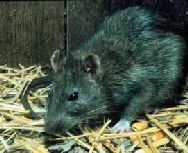
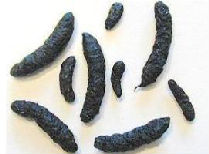
• Roof rat is also commonly known as the black rat and ship rat
• Color ranges from black to grizzled gray to tan with a light belly.
• The tail is longer than the combined head and body
• Droppings are up to 1/2 inch long and spindle-shaped
• Roof rats thrive in attics, roof spaces, palm trees, and ornamental shrubbery
• They are climbers and prefer to nest off the ground
• They can be quite destructive in attics, gnawing on electrical wires and rafters
• Roof rats generally prefer vegetables, fruits and grain; but they consume ½ to 1 ounce per day of food from various sources
• Roof rats live about 1 year and reach sexual maturity in 3-5 months
• They have 6-8 young per litter and up to 6 litters per year
House mice (Mus musculus)
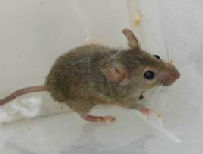
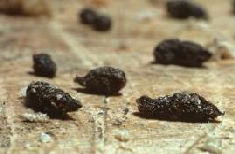
• House mice are considered among the most troublesome and economically important rodents
• The house mouse is a small, slender rodent that has a slightly pointed nose; small, black, somewhat protruding eyes; large, sparsely haired ears; and a nearly hairless tail with obvious scale rings
• Droppings are 1/8 inch long and rod-shaped
• House mice live in and around homes, farms, commercial establishments, and in open fields and agricultural lands
• Prefer to feed on grains but usually nibble at a wide variety of foods
• House mice live about 1 year and reach sexual maturity in 6 weeks
• They have 5-6 young per litter and up to 8 litters per year
Rodent Control
People or the specialist usually uses the mice catchers to control the mice, and they use many rat traps in order to catch the mice effectively. If 2 mice appear in the kitchen, then you can place 6 rat traps there (For instance, place 2 traps in back of the stove, 2 traps in back of the refrigerator, and the other 2 traps under the worktop. Usually the mice will be caught at the fist night. ). However, it may need to use a dozen of rat trap if you want to control the mice in the storeroom of a restaurant. Usually the mice catchers need to be placed near the areas that mice appear often, like the dark corners, wall sides or other sites with mice’s track. Mice’s action area is not large, so the distance between the mice catchers is about 10 feet. However, if the mice is bigger, then the distance between the traps should be about 15~20 feet. Put spicy food inside of the catcher to lure the mice comes to eat it, like hotdog, potato, peanut butter and so on.
If it is not work to lure the mice to eat the baits at the place where full of food, then you can use the material (cotton, styrofoam and so on) that mouse will take it to build their net, and tie the material with the hook of the catcher to lure the mice and catch them.
The mouse catchers also can be camouflaged if the mice are already very carefully and aware of the catchers. For example, hide the catcher on the dish that with food, but do not set the catcher. After the mouse has eaten the food once, then put the food inside of the catcher. Last, set the catcher and lure the mice come to eat the food.
Glue traps are easier to catch the mice than catching the other 2 kinds of rat. The usage of glue trap is same as the catcher, and also place the trap around the areas that the mice appear often. However, the efficacy of glue trap will be affected by the dust and water. Also, the higher or lower temperature will reduce the stickiness of the glue trap. Normally, it is no need to adding the food in the glue trap, but put the food in the middle of the glues trap also is good for luring the mice. Put the glue trap in the box of rodenticide is also a good way to lure the mice and catch them. The efficacy of the common glue traps are not good, so it is better to use more specialized ones. Glue trap is not work for Rottus rattu L. or Rattus norvegicus Erxleben if their 4 feet are not stuck on the trap, because they also can drag with the trap and run away, so it is better to fix the glue trap on an object to prevent the trap being moved away by the rat. Rodents’ feet are usually wet, so it is not easy to catch them by glue trap, however you can also put some papers around the trap to dry the rat’s feet before it comes to the trap.
Instructions for use mouse catchers or glue traps:
• Clean all the food before using mouse catcher or glue trap that can make the mouse only can get the food from the catchers.
• Keep the mouse catcher clean and usable.
• Put the mouse catcher inside a plastic bag when not use.
• The bottom of the mouse catcher can not be curvy or not flat, because that will make the mouse be more careful and aware of the catcher.
• Do not pick the dead body of mouse by hands in order to prevent suffering diseases.
• When maintaining the mouse catcher, it is better to use mineral oil to clean the catcher, because mineral oil does not have the unusual smell.
• Do not touch pet before using mouse catcher, because mice are sensitive and disgusted for pet’s smell (cat or dog).
ANTICOAGULANT:
The function of anticoagulant is to destroy the system of blood coagulants of mice and make them die of internal bleeding. Once the mouse ate the anticoagulant, it will die slowly after few days. The following are the advantages for using anticoagulants:
• Usually the mouse will die after 1 or 2 days and will not have any painful symptom obviously. Therefore mice will not have the association with death and rodenticide in their thinking, and they will still eat rodenticide.
• Anticoagulant is only slightly harmful for human being, cats or dogs. (However, some anticoagulants are harmful for pet.)
• The symptom of anticoagulant will break out slowly and we now also have a good antidote (Vitamin K or blood transfusion), so there is still enough time to cure the victim if he or she has eaten the anticoagulant incautious.
Usually, anticoagulant is used in producing the rodenticide block baits (grain type, small pack or wax block), liquid baits or tracking powders. Wax block baits and liquid baits the most common rodenticide. Wax Block bait can be applied in many places. Liquid baits can be applied in the dry places like granary or warehouse. Tracking powders are usually used together with the baits.
Preface
Rats will destroy our crops, steal or pollute our food, mice (rats, Rottus rattu L. and Mus caroli) even can deliver the disease, bite human being or livestock, snap doors, windows, sofas, furniture, and even bite the electric wires to cause a fire. Except using rodenticide to kill the mice, many people like to ask pest control operators to do the integrated rodent management (IRM). IRM means the integrating for the control methods of environmental improvement, physics and chemistry, and it can control the mice effectively. Mice are smart, so we have to use some techniques and methods to control them.
Observation of the place where mice appear: The first step for control the mice is to observe and check the place where already ruined by the mice. Also, try to get the information about: When and in which areas the mice appeared? If the voice of the mice been heard? Has anyone bitten by the mice? What food did the mice eat? If the wall, ceiling, cabinet, door, window, sofa, furniture, electric wire and computer have been ruined by the mice? Use a flashlight to check the place where already ruined by the mice in order to note more detail information.
Check the tracks of mice: Keep checking the mice tracks by following the result of checking the ruined place by mice. Use a flashlight to check the ruined placed carefully, including the wall corners, cabinets, work table, warehouse, gutter, basement, garbage and kitchen waste. You may find the following things:
• The fag end of the food that stolen by mice: If the fishbone, chicken bone or animal fag end were found, it probably the rodents stole them. If the peanuts or shells were found, it probably the mice store them.
• The excrement of mice: We can guess the type, age, quantity of mice by checking the shape, size, color, spread, amount, fresh degree of the mice.
• Biting traces of mice: Check the biting traces, and we can find the track of the mice to set the mouse catcher or rat glue trap and apply the rodenticide.
• Footprints of the mice: Mice will leave their footprints if they have passed the dusty or oily places. We can know the acting direction of the mice by their left footprints. If the mice’s footprints can not be found, you can spry some powder on the ground to let the mice leave their footprints.
• Mice hole: The mice hole net may be found in the ceiling, wall and floor.
• Mice net: Sometimes the whole net of mice can be found in the cabinet, drawer and warehouse.
• Mice Tracks: Sometimes the mice tracks can be found on the beam, water pipe and curtain.
• Mice urine: Use portable UV lamp to light the place where the mice appeared, and the fluorescent mice urine can be found.
Identification of the mice types: The mice types are different, and each type has its own characteristics and tastes of the food. Rodents are violent, and they have big appetite for food. Rottus rattu L. are alertly and leery, they don’t eat strange food or poison baits unless they observe it for few days, and they eat not much and try the food in the beginning, if they think the food is safe they will eat more. Mus formosanus like to eat food little by little. So the methods to control each type of mice should use different way.
Finding the reason or source why the mice came: According to the ruined areas by the mice, mice tracks and identification of the mice, we can find the attacking ways of the mice, analyze the reason of its reproduction, confirm the sources of its food and water and the environmental factors of mice’s building their nets. Those information give us the clues to control the mice.
Recording, Sketching and Setting files: Follow above mentioned checking result and record the detail information. Also, sketch the ruined places by mice, and note the ruined areas, mice tracks, attacking ways and mice’s source of food and water and set a file to save all of those useful information.
The methods for control the mice:
• Stop offering food and water to the mice: The food that not stored properly in house, exposed garbage and the feed for the livestock or pets are the major sources of water and food to mice. Especially, the problem of mice’s attacking is worse in restaurants, hotels, food stands and supermarkets. Also, the dumped food and garbage in the gutters are the best meals for mice. So, the first step is to stop offering food to the mice.
• Cleaning the environments: Sometimes people will ignore to check the hidden places in their building, and the places usually are the best ones for mice to build their nets. Cleaning the environments can make the mice to move out of the places. Also, it is reported that the control of mice can be more effective if proceed the clean of the environments and apply the chemical rodenticide together.
• Catching mice or poisoning mice: Some people would rather to endure the danger of mice than standing the bad smell from the dead mouse that killed by the poison baits. So, usually catching mice is more popular than poisoning mice. However, we must learn some skills before catching the mice. Use some wire to tie and fix the trigger of the mouse catcher and that will make the spring can’t be rebounded. So, in the beginning, the mouse can go and out of the catcher freely, and that can let down the mouse’s guard to the catcher. After 2~3days, release the wire and make the trigger/spring of the mouse catcher workable, and it can catch the mouse easier and more efficient. It is suggested to use the mouse catcher in a complex place, but use and apply the poison baits in a simple place.
• The way to catch mice: Use mouse glue trap to catch mice can avoid the dead mouse releasing bad smell. Also, the glue trap can catch the fleas on the dead mouse. Sometimes, one piece of glue trap can catch many mice.
• Selecting of the rodenticide: Acute rodenticide will make mice easily arise their guard to it, and it only can kill old and weak mice. Also, acute rodenticide contains of multi-amount of anticoagulants, and it may let mice have the resistance to the rodenticide. So when control of house mice, it is better to use the rodenticide with once amount. El-Naggar and Mikhail found the ether abstract of Citrus bergamia in 1999, and the ether abstract also has same efficacy as the anticoagulants rodenticide to control the mice, and especially it can control rodents effectively.
• Design of the baits: The eating habit of house mouse depends on the house host, so it is better to choose the baits in the house. So, check what food was stolen by the mice, and then use the food and re-mix it as poison baits to lure the mice to it. Rodents like to eat fish and meats, and Rottus rattu L. like to eat grains and fruits. So, it is need to check the eating habit of the mice before designing the poison baits.
• Plan for catching mouse and setting the bait stations: Mice are short sight and color blindness, and they usually act along with the walls. So it is also need to put the mouse catcher, rat glue trap or poison baits along with the walls, especially put it around the corner of the wall will be more effective. Sometimes mice are alert and smart, so we must use the landform to disguise the catcher, glue trap or baits.
• When the density of mice is high, we can use acute rodenticide (like trizinc diphosphide) to kill them, and it can decrease the density of mice quickly. However, use the prebaits first, and it still can receive the efficacy well.
Carrying out the plan of mice management: Follow the biological data to plan the ways for catching and killing the mice, and then set the mouse catcher or poison baits. The management of the mice should be safety and effectively.
• When use mouse catcher, auto mouse catcher and rat glue trap to control the mice.
• If use acute rodenticide, apply the baits in a box. Avoid child or pet to contact with it.
• Set a signal at the area where applied poison baits to prevent any accident.
• Handle the dead mouse properly, bury it or put it in a bag and give it to the garbage car. If the caught mouse is still alive, flood it with water or burn it.
• If the dead mouse released bad smell and has worms on it, try to take out the dead mouse and apply odor terminator, fungicide and pesticide. If the danger of the mice already been controlled, however we still need to prevent the attack by the mice that come from other places.
• Frequently clean the areas where the mice may hide there. The first step to control the mice is to clean the environments.
• Close the ways that the mice may pass through to prevent the mice from attacking us. Frequently check and repair the ceilings, walls, windows, doors and screens.
• Use ultrasonic rat repeller to close the way that the mice may pass through it.
• The disposal of use rodent repel: Use the rodent repel to seal the holes, ways that the mice may pass through. The rodent repel can drive the mice from entering the hole or way.
Monitoring the Density:
• Check the mice excrement: After checking the mice tracks, remove the feces and excrement that left by the mice. When in the period of eliminating the mice or after eliminating the mice, frequently check the area to see if there is any new feces or excrement that left by the mice. If the new feces and excrement still can be found, then it means elimination of the mice should still be carried. Also, change to place the poison baits at different areas.
• Assessment of the mice density (Monitoring by removing the mice after catching them): Use fixed amount of mouse catchers in one region. to catch the mice constantly and remove the mice. Then use Zippin statistic to calculate the mice density in the region. Also, it means to use the quantity of the caught mice daily to calculate the exposed population that caught by the mouse catcher in the region.
• Assessment of the mice density ( Symbolizing the caught mice): This way is to symbolize the caught the mice (cut their feet or ears). After that, set the caught and symbolized mice free at the same place and wait for a while to re-set the catchers. Calculate the quantity of the re-caught and symbolized mice, and then we can get the mice density of the region. When apply this way must assume the following 2 things:
1. The group of the mice is stable during the calculating period.
2. Each mouse of the group has the same probability of being caught, and the symbolized and non symbolized all have the chance to be caught.
• Assessing the mice density by consuming the baits: It is better to store well the food inside or out of the house before using this way, because this way is carried under the control of the food to mice. Put non-poison baits (like brown rice), and calculate the real consumed amount of the baits daily, and then divide the data by the average amount that each mouse eat daily to get the data of mice density.
• Using the catching way of rat glue trap to calculate the mice density.
Disposal of Dead Mice:
• It is easier to remove the dead mice on the glue trap than the ones that killed by the poisoned baits.
• Using a clam to remove the dead mice if possible.
• If the dead mice can not be removed, spray some quicklime on the dead mice and disinfect it to prevent the dead mice release bad smell and bugs.
Maintaining the performance and equipments of mice control: After eliminating the mice, close the mice holes and ways as soon as possible in order to prevent the outdoor mice from entering to the house. It is reported that apply some simple equipments to control the mice in house can decrease the danger of mice largely. Frequently clean the environments around the house to maintain the performance of eliminating the mice.
• Apply non-poison baits at the areas that the mice appeared before, and check the baits eaten or not weekly. Re-new or add baits frequently.
• Make sure the way to control the mice is good or not, and regularly strengthen it.
• Check if there is new mouse excrement, tracks, urine or the scouring they left.
• Check if any food bitten again by mouse, and also check if the walls, ceilings and furniture ruined by mouse again.
• Check if the closed entrances are still strong enough to stop the mice passing through it.
• Close the new entrance that mice may pass through it.
• If the mice already don’t eat the baits or poison baits.
• Check if the kitchen waste or garbage moved by mice or not.
• Follow the expiry date of the rodent repel to apply or strengthen it.
• Is there any sign that the mice still alive?
• The application of Ultrasonic Rat Repeller: Although there are still some arguments on the use of Ultrasonic Rate Repeller, but it was reported that if the power of the repeller is enough and the ultrasonic frequency can be adjusted constantly, then it also can control the mice effectively. Of course ultrasonic can’t remove the present mice in the building, but after eliminating the mice in the building, the ultrasonic rat repeller can be set at the entrances of the building to prevent the outside mice from entering the building.
Storage Pests
• Stored products include all durable agricultural commodities that can be dried and stored in bulk, such as cereal grains, flour, oil seeds, legumes, nuts, dried fruits, animal products, and packaged, baked or processed foods
• Insects have infested stored food products since the beginning of human civilization
Common stored pest species
Weevils (Family Curculionidae)
• The adult weevil can be readily identified by its long slender snout
• Adults are less than 3/16 of an inch in length, and color varies from medium brown to black
• The thorax is pitted with elongate depressions, and there are no wings under the wing covers, so the species is flightless
• The granary weevil female chews a small hole in a kernel, into which she deposits an egg
• Each female can deposit between fifty and two hundred and fifty eggs
Lesser Grain Borer (Rhizopertha dominica)
• The adults of this species are readily distinguished by the squared-off appearance at the front of the body
• The adults are less than 1/8 of an inch in length and range from reddish brown to dark brown
• This species is a good flier, and adults are readily trapped in pheromone-baited traps at harvest
• The lesser grain borer is a long-lived species and a female can lay up to 500 eggs
• Heavy infestation with lesser grain borers can be identified by a sweetish, musty odor in the storage. This odor is a result of the male-produced aggregation pheromone that has been demonstrated to be an effective lure for use in traps
Flour Beetle (Tribolium castaneum)
• These elongate, shiny beetles have short, clubbed antennae
• Flour beetle is seldom found in grain and is more often associated with milled products
• The insects reproduce faster when some fine material is present in the stored grain especially if grain moisture is more than 12%
• Under optimal conditions females can lay up to 450 eggs over a lifespan that may be as long as eighteen months
• The adults are good fliers
• A pungent, bad odour in the grain is a sign of a large infestation of flour beetles
Drugstore Beetle (Stegobium paniceum)
• The adults are about 1/10 of an inch in length, cylindrical and uniform brown with fine silky hairs
• The adult drugstore beetle has a three-segmented, saw like antennae that is pressed to the body when at rest
• This beetle lays eggs in almost any dry organic substance
• The entire life cycle may be passed in less than two months
Tobacco Beetle( Lasioderma serricorne)
• The tobacco beetle is a small stout, oval, reddish-yellow or brownish-red beetle, with the head bent down nearly at a right angle to the body
• It varies in size, but is usually about 1/10 of an inch long
• The antennae of the tobacco beetle are saw-like and the head is somewhat retracted
• The adult tobacco beetle lives 2 to 4 weeks, during which time each female may lay as many as 100 eggs
Rusty Grain Beetle (Cryptolestes spp.)
• These small insects (2 mm) are readily identified by their very long antennae
• The antennae of both male and female rusty grain beetles are about half the length of the body
• The rusty grain beetles have been recorded from wheat, flour, oilseeds, cassava root, dried fruits, and chilies
• The adults are good fliers
• Females can lay up to 400 eggs over a lifespan of up to nine months
Saw-Toothed Grain Beetle (Oryzaephilus surinamensis)
• Saw-toothed grain beetle is a slender, flat, brown beetle about 1/10 of an inch long
• It gains its name from the peculiar structure of the thorax, which bears six saw tooth-like projections on each side
• The female beetle lays 43 to 285 eggs
• Eggs are deposited on cracks in the kernels and adults and larvae feed on damaged kernels, fines, and occasionally the germ of the intact grain
• This species is a good flier, but is most commonly associated with areas of high temperature and humidity
Khapra Beetle (Trogoderma granarium)
• The adults are oblong-oval beetles, approximately 1.6 to 3.0 mm long by 0.9 to 1.7 mm wide
• Males are brown to black with indistinct reddish brown markings on elytra. Females are slightly larger than males and lighter in color
• The head is small and deflexed with a short 11-segmented antennae
• The antennae have a club of three to five segments
• The adults are covered with hairs
• Adult khapra beetles have wings, but apparently do not fly and feed very little
• This beetle has never been observed to fly; therefore, its spread is probably dependent on movement of infested goods or in containers where it may be transported while in diapauses
Angoumois Moth (Sitotroga cerealella)
• Angoumois grain moth adults are brownish gray, slightly less than 1/2 inch long, with a long fringe of hairs on the wings
• The forewings are clay-yellow and without markings; the hindwings are gray
• Angoumois grain moths can be found infesting a variety of grain and food materials. They attack all cereal grains, however are most often found in corn and wheat
• It is the only storage pest that will attack standing grains in the field
Indianmeal Moth (Plodia interpunctella)
• Adult moths are about 3/8-inch (8 to 10mm) long when at rest and have a wing spread of about 1/2 to 3/4 inch (18 to 20mm)
• The overall body color is generally dirty gray but the tip half of the wing is rusty brown or nearly bronze
• This wing marking pattern allows Indian meal moth to be easily distinguished from other household moths
• Indian meal moths develop in many kinds of stored foods. Coarsely ground grains and cereal products are commonly infested
Termites
• Termites are social insects living in colonies comprised of a king and a queen (wingless adults or nymphs, depending on the species), and soldiers
• The king and queen perform the reproductive functions of the colony, while the workers carry on all aspects of colony maintenance
• The soldiers defend the colony
• These individuals, separated by divisions of labour, are referred to as castes
• Termites feed on wood or wood products, and their digestive tracts contain microorganisms which enable them to convert the cellulose in wood into usable food
Common termite pest species
Drywood termites
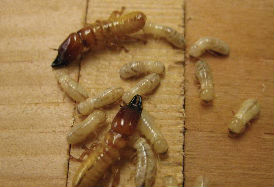
• Drywood termites are social insects that live in colonies in sound, dry wood
• In comparison to other termites, drywood colonies are rather small (a few thousand individuals), and the colony develops slowly
• They neither live in the ground nor maintain contact with the soil, and they do not build mud tubes
• Drywood termites produce dry fecal pellets compared to subterranean termites that produce liquid feces
• Drywood termites tend to feed across wood grain impacting both the soft spring wood and the harder summer growth
• Dead trees, branches, brush and firewood from residential areas are the primary habitat of drywood termites
Dampwood termites
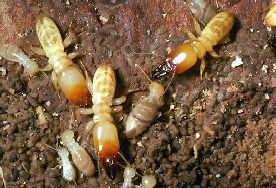
• Dampwood termites are found only in wood with high moisture content
• Dampwood termites do not usually infest structures because of the low moisture content of wood in structures
• Dampwoods are considered a minor structural pest, but they can do substantial damage if left unchecked
• Dampwood termites produce distinctive fecal pellets that are rounded at both ends, elongate, and lack the clear longitudinal ridges common to drywood termite pellets
• Dampwood fecal pellets are often stuck together along the bottom or sides of the tunnels or may dissolve into a muddy paste
• Infested wood usually shows no external damage because openings in the wood are plugged with fecal material
• They nest in wood buried in the ground, although contact with the ground is not necessary when infested wood is high in moisture
Subterranean and mound-building termites
1. Coptotermes spp.
• Coptotermes species is one of the most destructive termites in Asia
• In Malaysia and Singapore, Coptotermes spesies alone is responsible for at least 80-90% of damage to human built structures, based on past statistics, and it is the most common termite species in all urban areas
• They have a voracious appetite for anything wood or paper, and may even attack fabric
• Their nests are located deep underground
• They have a large and conspicuous fontanella
• They secrete a white, sticky liquid upon biting, through the fontanelle
2. Macrotermes spp.
• The Macrotermes genus are the largest termite species of all
• Most species of Macrotermes build mounds, although there are a few subterranean species
• Macrotermes species are noted for having two sizes of workers and two sizes of solders (major and minor workers and soldiers).
• The unique thing about Macrotermes termites is their fungus cultivation habit
3. Globitermes sulphureus
• Globitermes sulphureus is a species of termite that is very common in present in other areas of South East Asia, including Malaysia
• They live in nests made of earth that can be up to 1.5m tall and can contain tens of thousands of individuals
• Between 5% and 10% of the population are soldier termites which can be recognised by their yellow abdomen and two large, curved mandibles
• When the nest is damaged, the soldier termites defend the nest and workers rapidly repair any damage to the nest walls
• In some cases, the contractions are so violent that the termites rupture themselves. This form of suicidal altruism is known as autothysis
4. Microcerotermes spp.
• This species is 3.15-7.75mm long
• They have long rectangular heads and long fine mandibles that are finely serrated when viewed with a microscope
• Some species may build small mounds nest underground and some may make arboreal nests and nest on top of posts
• Their nesting habits (mounds, arboreal nests) often betray their presence and facilitate their control
5. Schedorhinotermes spp.
• The average length of this species of termite is 3-7mm long
• The major soldiers have bulbous heads.
• The minor soldiers are usually about two-thirds of the length of the major soldiers
• They have narrower heads and more slender mandibles with their labrums extend and almost to the tip of the mandibles
• This species of termite nest in root crown and lower trunk of living and dead trees
Termite control: the unseen pest
Responsible for 95% of the termite damage in the Malaysia, subterranean termites are unusual pests because they are seldom seen until after substantial damage has been done. As their name suggests, subterranean termite colonies live in underground nests. Worker termites come above ground to feed on wood, but remain out-of-sight by entering directly into wood that contacts the ground, through cracks in concrete as small as 1/64th of an inch, or by constructing tell-tale “mud tubes” over physical obstacles to get wood above. When feeding, termites hollow out long galleries following the grain of wood and are careful not to break through the wood surface. Each “bite” of wood a worker termite takes is smaller than the period at the end of this sentence. However, a mature colony of subterranean termites can do considerable damage since it may have several hundred thousand or more workers, each feeding several times per day. The end result – wood that looks perfectly solid, yet crumbles when even slight pressure is applied. In warm areas, termite attacks on homes can be year-round.
Termite facts
• No home, including those made of bricks or stone, is immune to termite attack. Furniture, books and decorations are subject to attack even when building is made of concrete.
• Termites are found in every corner of the world, particularly those with tropical temperate climates.
• Wood is a primary food for termites, but they also attracted to books, shoes, furniture, and other material containing cellulose.
• A mature subterranean termite colony can number more than 250,000 insects.
• Termites will construct “mud tubes” to cross over concrete walls, pipes and other physical barriers. They have been known to construct free-standing mud tubes more than three (3) feet high to reach from the ground to the sub-flooring above.
• Winged “swarmer” termites are usually seen in the spring and are a sign that a mature colony is nearby. Unlike winged ants, swarming termites have four wings of equal length, a thick waist, and straight, bean-like antennae. Swarmers search for a moist niche in the soil in which to lay eggs and establish a new colony. Within several years a colony will grow large enough to damage buildings and a relatively small area can harbor several colonies. If swarmers are seen, a professional pest control operator should be called to perform an inspection.
Termite control: termiticide application
The gold in termite control is to install a continuous barrier of termiticide in the soil around and beneath the home or structure. This treated soil prevents termites from entering the building and attacking wood. The ideal time to make a termidicide application is in the early stages of construction. Called a pre-construction treatment, this application is made after all plumbing, wiring and other utility lines have been installed in the soil, but before a concrete slab is poured. Pre-construction applications allow pest control operators to see the soil as they treat it and help to ensure through termidicide coverage. Pre-construction applications are generally easier to perform, since there are no structural obstructions. Termidicide soil treatment can also be made to an existing building. Known as a post-construction treatment, these applications usually require digging in the soil and drilling through concrete or masonry to allow the termiticide to be injected into the soil below. Expert knowledge by the applicator is needed to ensure all necessary areas are treated.
Choosing a Pest Control Company
• Get at least three quotes. The lowest price does not always mean the best deal. When shopping for a pest control professional, ask specifically for the amount of experience they have in dealing with subterranean termite control. Clarify the type of coverage (such as service after the sale) you can expect with a particular contract.
• The pest control company should make a complete inspection of the entire building to determine the origin and the extent of the infestation. This inspection is extremely important because without a thorough inspection, proper treatment cannot be recommended. You should be given a written report stating the extent of the infestation and probable origin (ground or aerial) with a graph indicating areas of activity. The report also details what structures or areas will be treated and how, what product or insecticide and rate will be used, and any warranty or limitations to the treatment.
• Ask if the contract makes any distinction between the subterranean termite and native subterranean termite. Any company whose contract makes a distinction probably realizes the need for this separation.
• Ask for references on completed subterranean termite work. Do not be pressured by a company to treat your structure immediately (today). Taking a couple of weeks to thoroughly research treatment options and different pest control companies is not unreasonable. Ask if they object to a second opinion concerning the method of treatment or extent of damage.
Copyright 2010-2025. Syarikat Perniagaan M.S. (Malaysia) Sdn. Bhd. (57718-M) All Rights Reserved.

